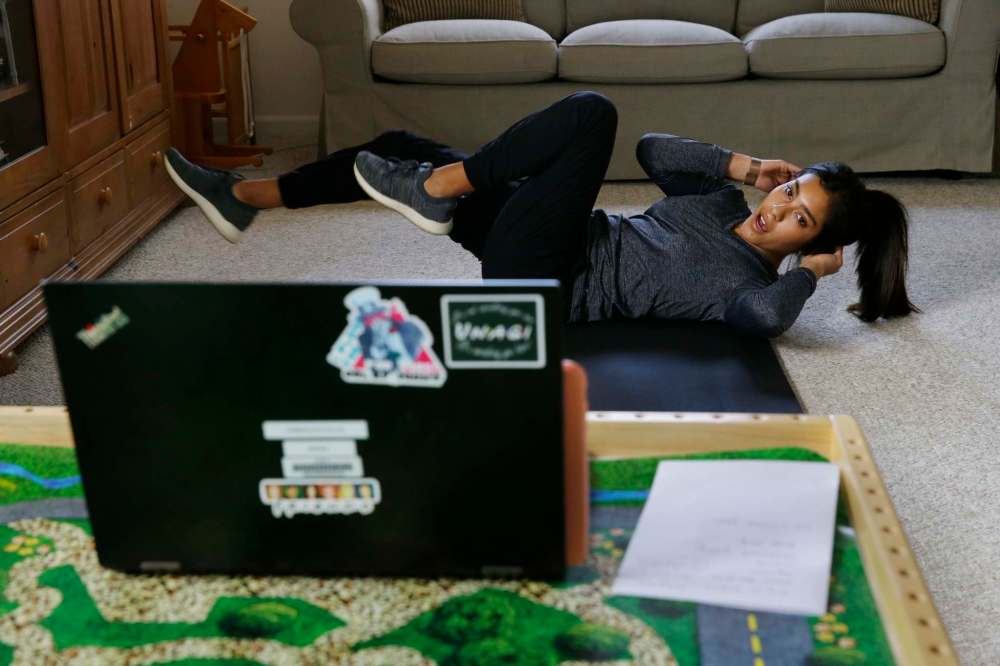Time to manage your motivation
Consistent plan is essential for fitness gains
Advertisement
Read this article for free:
or
Already have an account? Log in here »
To continue reading, please subscribe:
Monthly Digital Subscription
$1 per week for 24 weeks*
- Enjoy unlimited reading on winnipegfreepress.com
- Read the E-Edition, our digital replica newspaper
- Access News Break, our award-winning app
- Play interactive puzzles
*Billed as $4.00 plus GST every four weeks. After 24 weeks, price increases to the regular rate of $19.00 plus GST every four weeks. Offer available to new and qualified returning subscribers only. Cancel any time.
Monthly Digital Subscription
$4.75/week*
- Enjoy unlimited reading on winnipegfreepress.com
- Read the E-Edition, our digital replica newspaper
- Access News Break, our award-winning app
- Play interactive puzzles
*Billed as $19 plus GST every four weeks. Cancel any time.
To continue reading, please subscribe:
Add Free Press access to your Brandon Sun subscription for only an additional
$1 for the first 4 weeks*
*Your next subscription payment will increase by $1.00 and you will be charged $16.99 plus GST for four weeks. After four weeks, your payment will increase to $23.99 plus GST every four weeks.
Read unlimited articles for free today:
or
Already have an account? Log in here »
Hey there, time traveller!
This article was published 16/11/2020 (1796 days ago), so information in it may no longer be current.
My heart pounded. I tried to make myself as small as I could at the back of the gym. My anxiety was reaching a fever pitch.
“Oh, no,” I thought. “Everyone is going to laugh at me.”
The year was 2002 and my gym teacher was making the rounds with this cool new technology, a hand-held body-fat measurement device. And he figured it was a good idea to get everyone tested (Not something you’d see these days, I imagine!)

The Omron body-fat tester told me everything I already knew — I was fat. And I’m sure I made it worse in my head when I relive it now, as only one kid made a snide remark afterwards.
But I remember it like it was yesterday. That pit-in-my-stomach feeling still comes back sometimes; it was a defining moment in my weight-loss journey.
So how did I go from introverted, overweight video-game addict to a “disciplined” fitness coach who now writes this column and helps others shed their own weight demons?
Well, through the ups and downs of losing 60 pounds and later helping hundreds of people take similar journeys of their own, I like to think I learned a thing or two about a thing or two.
The best education didn’t come from books, certifications or studies I’ve invested in these past 18 years but by being in the trenches with people confronting their own barriers.
It’s not the weight itself but what the weight represents: a life unfulfilled. I knew being that weight was not going to give me the life I wanted. I had few friends and no girls wanted to talk to me in high school.
Maybe it was partly my lack of presence rather than the actual weight, but either way I knew getting in shape was the first step I needed to take for my own sake. That was initial surface-level motivation.
Now I know more than ever how important discovering fitness can be. Some clients who lost their weight told me later they were contemplating suicide before changing the course of their life. Some clients who lost their weight said it saved their marriage. Some clients who lost their weight said it helped them get more done at work and win a life-changing promotion.
Like it or not, you are judged on your physical fitness and how you carry yourself. The return on the investment of getting in shape is 10 times the time and effort invested, easily. You understand that or you wouldn’t have read this far, but how do you create the consistency necessary to achieve success?
I boil it down to three critical factors.
1. Improve structure, routine and discipline
Begin with your habits. Most people try to add too much change too fast.
You want to go all-in on one or two. Remember, you’re trying to make this new habit automatic. If I was building a new habit of a workout routine, I would schedule it on my calendar every day at the same time seven days per week.
Then, even if I was taking a day off from intense workouts, I would still put on my workout clothes, go to the gym (or home workout space, in this case), and just do something. Literally anything resembling exercise.
The point is to ingrain behaviour by repeating it at the same time, in a similar manner, every day, until it becomes automatic.
Consistent with that is what I picked up from mentor Craig Ballantyne: have a “diet uniform.”
Meaning you find a few things you can eat daily for breakfast and lunch. It eliminates decision fatigue, you know how your energy responds to these foods, and it gives you a bigger buffer to have a “flexible” dinner at night when you have time for such things.
2. Control your environment
Control what’s around you and eliminate distractions. Put away the snacks when it’s not snack time. Don’t have your kryptonite food within arm’s reach at all times.
You may know about my personal Law of Red Velvet Cake. It goes like this:

If the delectable cake doesn’t get into my car, it doesn’t get home. And if it doesn’t get home, it doesn’t get in my mouth. And if it doesn’t get in my mouth, it doesn’t contribute to belly fat.
Another part of controlling your environment is avoiding bad influences.
If there’s negativity bringing you down, or someone routinely pushing pizza in your face, distance is the best policy.
3. The ADC formula
Humans tend to procrastinate in the absence of something I call ADC (accountability, deadline and consequence).
It starts with outsourcing accountability to someone you do not want to disappoint, setting a deadline to achieve your goal and adding a consequence if you don’t follow through.
There will come a time in your journey when your first instinct is to throw in the towel. But it’s necessary to have some level of discomfort to grow. I’ve heard it referred to as “the Suck” and it separates success from failure.
I want you to reframe how you see the Suck. Because it’s actually a beautiful thing that leads to a life of fulfilment. It’s giving up things that don’t serve you in becoming the person you want to become.
And, naturally, your “old self” will fight you on that. It doesn’t want to become obsolete. But a better version of you awaits on the other side.
Summarizing the ADC Formula:
1. Enlist some accountability to follow through (publicly share it with friends and family or join a program).
2. Set a hard deadline around your primary goal right now. If it’s weight loss, something like “lose 15 pounds by Jan. 15.”
3. Set up a reward or consequence for yourself at the end or at specific intervals. It’s best to tie it to performance, not outcome: for example, completing 10 workouts this month. If you want a behaviour change to stick (especially in the early “grind” months before it becomes habitual), there has to be something on the line.
Depending on how you’re wired, a reward or consequence (carrot or stick) is the extra piece involved here. The carrot means you get a significant reward for accomplishing your goal, while the stick means you get a significant punishment. Think about which one better motivates you and put a plan in place focused around your reward or consequence.
You’ll see more results in 90 days than you have in years if you tie your goal to a deadline. So set a tough deadline and go for it. If you need some accountability around your goal, reach out. I’m ready when you are.
Mitch Calvert is a Winnipeg-based fitness coach for men and women like his former self. Heavyset in his 20s, he lost 60 pounds and now helps clients find their spark and lose the weight for life. If you want to make the most of the last seven weeks of 2020 and boost your overall health and sanity during these challenging times, visit mitchcalvert.com for details on his next virtual Drop 2 Sizes Challenge.

Our newsroom depends on a growing audience of readers to power our journalism. If you are not a paid reader, please consider becoming a subscriber.
Our newsroom depends on its audience of readers to power our journalism. Thank you for your support.


